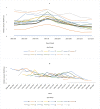The influence of the age-period-cohort effects on male suicide in Brazil from 1980 to 2019
- PMID: 37053241
- PMCID: PMC10101429
- DOI: 10.1371/journal.pone.0284224
The influence of the age-period-cohort effects on male suicide in Brazil from 1980 to 2019
Abstract
Suicide is a complex and multi-determined phenomenon. Higher rates are observed in men and are related to multiple risk factors, including mental disorders, financial crises, unemployment, and easy access to highly lethal means of perpetration, such as firearms. We studied the effects of age, period, and cohort (APC) on total and firearm-related suicides in men in Brazil and its major regions from 1980 to 2019. Death records were extracted from the Brazilian Ministry of Health's Mortality Information System. Estimable functions were used to estimate APC models, through the Epi library of the R statistical program, version 4.2.1. During the study period, Brazil had an average rate of 10.22 deaths per 100,000 men. Among regions, rates ranged from 8.62 (Northeast) to 16.93 (South). The same profile was observed in suicides by firearms. After estimating the APC models, we observed a temporal trend of increasing total suicides for Brazil and regions, except for the South region, where the trend was stationary. The trend was downward for firearm suicides for all locations. A positive gradient was observed in the mortality rate with advancing age for total suicides; and peak incidence between 20-29 years, with subsequent stabilization, for suicides perpetrated by firearms. There was a reduction in the risk of death for suicides perpetrated by firearms in relation to the reference period (1995-1999) for all locations, except in the North region, where the effect was not significant. The younger generations from the 1960s onwards had a higher risk of death from total suicide and a lower risk for those perpetrated by firearms in relation to the reference cohort (1950-1954). We observed a reduction in the mortality trend for suicides perpetrated by firearms, a reduction in the risk of death in the 2000s and for men born after 1960. Our results suggest reducing the risk of death from suicide by firearms in Brazil and regions. However, there is an upward trend in mortality from total suicides in the study period (1980-2019) and for younger cohorts.
Copyright: © 2023 Rodrigues et al. This is an open access article distributed under the terms of the Creative Commons Attribution License, which permits unrestricted use, distribution, and reproduction in any medium, provided the original author and source are credited.
Conflict of interest statement
The authors have declared that no competing interests exist.
Figures








Similar articles
-
Suicide methods among Brazilian women from 1980 to 2019: Influence of age, period, and cohort.PLoS One. 2024 Dec 13;19(12):e0311360. doi: 10.1371/journal.pone.0311360. eCollection 2024. PLoS One. 2024. PMID: 39671434 Free PMC article.
-
Analysis of age, period, and birth cohort effects on suicide mortality in Brazil and the five major geographic regions.BMC Public Health. 2023 Jul 13;23(1):1351. doi: 10.1186/s12889-023-16289-0. BMC Public Health. 2023. PMID: 37442995 Free PMC article.
-
Identifying Points of Prevention in Firearm-Related Suicides: A Mixed-Methods Study Based on Coronial Records.Arch Suicide Res. 2022 Oct-Dec;26(4):1815-1830. doi: 10.1080/13811118.2021.1938322. Epub 2021 Jun 22. Arch Suicide Res. 2022. PMID: 34157235
-
Firearm Suicides in the Elderly: A Narrative Review and Call for Action.J Community Health. 2021 Oct;46(5):1050-1058. doi: 10.1007/s10900-021-00964-7. Epub 2021 Feb 5. J Community Health. 2021. PMID: 33547617 Free PMC article. Review.
-
Impact on Nonfirearm Deaths of Firearm Laws Affecting Firearm Deaths: A Systematic Review and Meta-Analysis.Am J Public Health. 2020 Oct;110(10):e1-e9. doi: 10.2105/AJPH.2020.305808. Epub 2020 Aug 20. Am J Public Health. 2020. PMID: 32816550 Free PMC article.
Cited by
-
Age, period and cohort analysis of suicide trends in Australia, 1907-2020.Lancet Reg Health West Pac. 2024 Aug 13;51:101171. doi: 10.1016/j.lanwpc.2024.101171. eCollection 2024 Oct. Lancet Reg Health West Pac. 2024. PMID: 39247208 Free PMC article.
-
Smooth predictions for age-period-cohort models: a comparison between splines and random process.BMC Med Res Methodol. 2025 Jul 28;25(1):177. doi: 10.1186/s12874-025-02629-8. BMC Med Res Methodol. 2025. PMID: 40721740 Free PMC article.
-
Suicide methods among Brazilian women from 1980 to 2019: Influence of age, period, and cohort.PLoS One. 2024 Dec 13;19(12):e0311360. doi: 10.1371/journal.pone.0311360. eCollection 2024. PLoS One. 2024. PMID: 39671434 Free PMC article.
-
Trend analysis and age-period-cohort effects on morbidity and mortality of liver cancer from 2010 to 2020 in Guangzhou, China.Front Oncol. 2024 May 2;14:1387587. doi: 10.3389/fonc.2024.1387587. eCollection 2024. Front Oncol. 2024. PMID: 38756657 Free PMC article.
-
Effect of the COVID-19 Pandemic on Suicide Mortality in Brazil: An Interrupted Time Series Analysis.Int J Environ Res Public Health. 2025 Jan 21;22(2):138. doi: 10.3390/ijerph22020138. Int J Environ Res Public Health. 2025. PMID: 40003364 Free PMC article.
References
-
- World Health Organization. Suicide worldwide in 2019: global health estimates. Geneva, 2021.
-
- Brasil, Ministério da Saúde, Secretaria de Vigilância em Saúde. Mortalidade por suicídio e notificações de lesões autoprovocadas no Brasil. Boletim Epidemiológico, Brasília [Internet]. 2021 [cited jan 2023]. https://www.gov.br/saude/pt-br/centrais-de-conteudo/publicacoes/boletins....
-
- Durkheim E. O Suicídio: estudo de sociologia. São Paulo: Martins Fontes, 2019.
Publication types
MeSH terms
LinkOut - more resources
Full Text Sources
Medical

